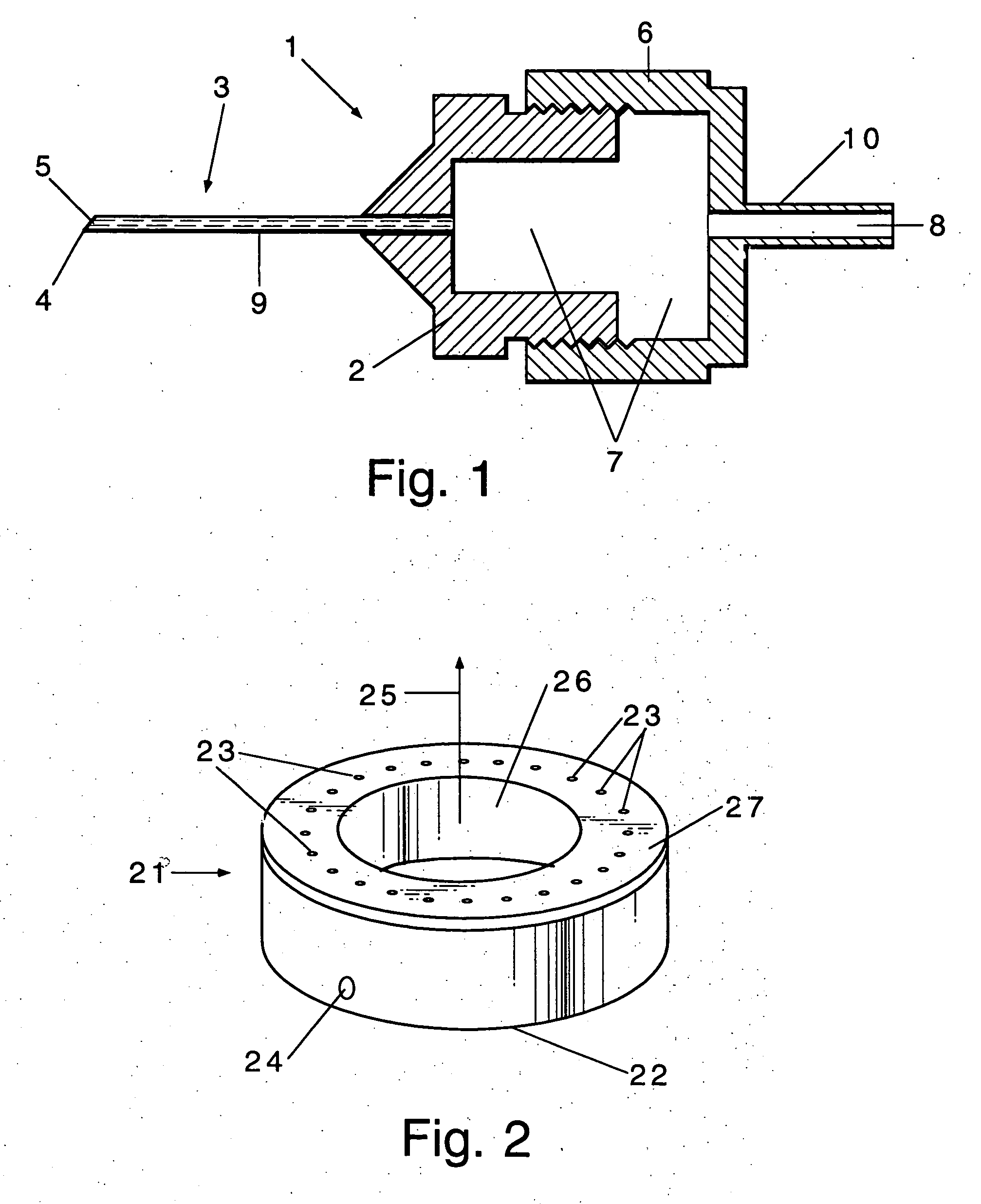Electrostatic atomizer and method of producing atomized fluid sprays
a technology of atomizer and atomizer, which is applied in the field of atomizer, can solve the problems of unburned hydrocarbon emissions, the formation of deposits in the engine, and the limited combustion process,
- Summary
- Abstract
- Description
- Claims
- Application Information
AI Technical Summary
Problems solved by technology
Method used
Image
Examples
example 1
Isopropanol is fed to a 200 μm internal diameter stainless steel hypodermic needle with a pointed tip, with just enough applied hydrodynamic pressure (less than 1 inch water) to maintain a steady stream of fluid to the needle tip. No droplets or mass flow out of the needle is seen until a voltage is applied to the needle. A rectified, 330 Hz, 3-4 kV voltage is supplied to the needle. Droplets (<100 μm diameter) are formed in a single droplet mode. Injection velocity is estimated at 75 mm / s, with slowing due to air drag as the droplets traveled. Power consumption can not be measured because of an extremely low Lissajou current.
example 2
Isopropanol is fed into a 100 μm internal diameter stainless steel needle with a sharp tip, under a pressure equal to approximately 2″ water. An unpulsed DC voltage is applied to the needle. Approximately 4000 volts DC are required to initiate atomization. At about 5000 volts, droplet formation assumes a spray mode with approximately 10 μm / minute mass flow rates. Current consumption at this voltage is about 40 μA. Droplets are very uniform in size and are approximately 30 μm in diameter. Further increasing the DC voltage decreases droplet size and increases mass flow rates, droplet velocity, and dispersion angle.
The applied voltage is then changed to a 100 Hz, 10 kV rectified voltage. A significantly higher mass flow rate, smaller droplet formation and smaller dispersion angle are generated, compared to what is produced with a similar DC voltage. Further, the system can tolerate higher applied hydrodynamic pressures when a pulsed voltage mode of operation is used, as droplet form...
example 3
A mixture of ethanol and less than 0.1 weight percent bacterial spores is prepared. This mixture is atomized using a 620 μm (ID) stainless steel hypodermic needle with a square wave-driven (28 Hz), 20 kV applied voltage and no applied hydrodynamic pressure. Fine droplets in a spray mode are formed.
Similar results are obtained using a 220 μm (ID) needle, or when a 20 kV DC current is applied.
A mixture of water and less than 0.1 weight percent bacterial spores is prepared and atomized using the same 620 μm (ID) stainless steel hypodermic needle with a square wave-driven (28 Hz), 20 kV applied voltage and no applied hydrodynamic pressure. A bimodal spray distribution is observed. The spray assumes a generally conical pattern, with the bacterial spores concentrated in the region near the axis of the cone. Similar results are seen using a 220 μm needle or a 20 kV DC voltage.
PUM
 Login to View More
Login to View More Abstract
Description
Claims
Application Information
 Login to View More
Login to View More - R&D
- Intellectual Property
- Life Sciences
- Materials
- Tech Scout
- Unparalleled Data Quality
- Higher Quality Content
- 60% Fewer Hallucinations
Browse by: Latest US Patents, China's latest patents, Technical Efficacy Thesaurus, Application Domain, Technology Topic, Popular Technical Reports.
© 2025 PatSnap. All rights reserved.Legal|Privacy policy|Modern Slavery Act Transparency Statement|Sitemap|About US| Contact US: help@patsnap.com



